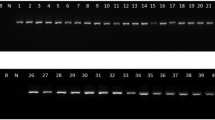Abstract
The Western Ghats of India is the one of the world’s 10 “Hottest biodiversity hotspots” that runs along the western part of India through four states including Tamil Nadu. The only biodiversity reserve in the Western Ghats is the Nilgiri biosphere located in the Tamil Nadu state. In the present study, 525 soil samples were collected from all the 14 different divisions of the Western Ghats in Tamil Nadu state, India. A total of 316 new isolates of Bacillus thuringiensis (Bt) that produce parasporal crystalline inclusions were isolated from 525 soil samples. Seven different types of crystalline inclusions were observed in the 316 new isolates of Bt. Cuboidal inclusion was predominantly present in 26.9% of the Bt isolates when compared to other shapes. Further characterization of 70 of the 316 Bt isolates for crystal protein profile through SDS-PAGE revealed six different types of crystal protein profile viz., 135 and 65, 135, 95, 65, 43, and 30 kDa crystal proteins. Variation in the mass of crystal protein(s) purified from the isolates of Bt revealed molecular diversity of this bacterium prevalent in the Western Ghats of Tamil Nadu, India.



Similar content being viewed by others
References
Bernhard K, Jarrett P, Meadows M, Butt J, Ellis DJ, Roberts GM, Pauli S, Rodgers P, Burges HD (1997) Natural isolates of B. thuringiensis: worldwide distribution, characterization and activity against insect pests. J Invertebr Pathol 70:59–68
Chambers JA, Jelen MP, Gilbert T, Johnson B, Gawron CB (1991) Isolation and characterization of a novel insecticidal crystal protein gene from Bacillus thuringiensis subsp. aizawai. J Bacteriol 173:3966
Feitelson JS, Payne J, Kim L (1992) Bacillus thuringiensis: insects and beyond. Nat Biotechnol 10:271–275
Itoua-Apoyolo C, Drif L, Vassal JM, De Barjac H, Bossy JP, Leclant F, Frutos R (1996) Isolation of multiple species of Bacillus thuringiensis from a population of the European Sunflower moth, Homoeosoma nebulella. Appl Environ Microbiol 61:4343–4347
Kaur S, Singh A (2000) Distribution of Bacillus thuringiensis isolates in different soil types from North India. Indian J Ecol 27:52–60
Laemmli UK (1970) Cleavage of structural proteins during the assembly of the head of Bacteriophage T4. Nature 227:680–685
Martin PAW, Travers RS (1989) Worldwide abundance and distribution of B. thuringiensis isolates. Appl Environ Microbiol 55:2437–2442
Rampersad J, Ammons D (2005) A Bacillus thuringiensis isolation method utilizing a novel stain, low selection and high throughput produced atypical results. BMC Microbiol 5:52–63
Schnepf E, Crickmore N, Van Rie J, Lereclus D, Baum J, Feitelson J, Zeigler JDR, Dean DH (1998) B. thuringiensis and its pesticidal crystal proteins. Microbiol Mol Biol Rev 62:775–806
Uribe D, Martinez W, Ceron J (2003) Distribution and diversity of cry genes in native strains of B. thuringiensis obtained from different ecosystems from Colombia. J Invertebr Pathol 82:119–127
Wang J, Boets A, van Rie J, Ren G (2003) Characterization of cry1, cry2 and cry9 genes in B. thuringiensis isolates from China. J Invertebr Pathol 82:63–71
Xue J, Liang G, Crickmore N, Li H, He K, Song F, Feng X, Huang D, Zhang J (2008) Cloning and characterization of a novel Cry1A toxin from Bacillus thuringiensis with high toxicity to the Asian corn borer and other lepidopteran insects. Microbiol Lett 280:95–101
Acknowledgments
Authors express sincere thanks to Dr. V. Balasubramani, Assoc. Prof., Dr. P. S. Shanmugam, Senior Research Fellow and Dr. V. Maheswaran, Senior Research Fellow, Tamil Nadu Agricultural University, for their help in the collection of soil samples. Authors are thankful to Dr. P. U. Krishnaraj, Project Coordinator, University of Agricultural Sciences, Dharwad, India. This research was supported by a grant from the Department of Biotechnology, Government of India, New Delhi (BT/PR5349/AGR/02/274/2004).
Author information
Authors and Affiliations
Corresponding author
Rights and permissions
About this article
Cite this article
Ramalakshmi, A., Udayasuriyan, V. Diversity of Bacillus thuringiensis Isolated from Western Ghats of Tamil Nadu State, India. Curr Microbiol 61, 13–18 (2010). https://doi.org/10.1007/s00284-009-9569-6
Received:
Accepted:
Published:
Issue Date:
DOI: https://doi.org/10.1007/s00284-009-9569-6




